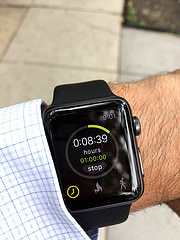It wasn’t that long ago that our lives had far fewer conveniences than we have now.
For example, consider the Rachio 3 Smart Watering System. This smart watering system brings together the convenience of a smartphone sprinkler control with features so advanced that the system actually tracks your local weather information to determine when it should water your lawn or not.
It is so cutting-edge that it offers an add-on feature that detects leaks and will shut the system down automatically if it detects a leak to save water. The mobile app allows you to customize watering schedules and monitor usage.
Or, consider the Ring Alarm system. With the Ring Alarm, you can always know what’s happening in your home. The Ring system sends alerts right to your smartphone when an alarm is triggered. The alarm can be triggered by a ringing doorbell, a contact sensor being triggered by a door or window opening, or by a motion detector being triggered.

From the mobile app on your smartphone, you can see what is happening at home via cameras that are started when the alarm is triggered.
From the mobile app on your smartphone, you can see what is happening at home via cameras that are started when the alarm is triggered. Or you can control the alarm and or Ring doorbells and cameras directly from the mobile app while you are at work or on vacation.
It seems as if the future is already here and it’s called the Internet of Things (IoT).
The Internet of Things
The Internet of Things is a network of devices, other than smartphones, where these devices are connected to and exchanging data via the internet. This includes vehicles, appliances, electronics, and many, many other devices.
Devices are able to do this because they individually have an IP address and the capacity to send and receive information without needing a person to be involved. This sending and receiving of information is automated. Additionally, these devices are able to communicate with other devices and can be utilized to enhance our lives. Consider the example I mentioned at the beginning of this article of an automated watering system that not only adjusts due to weather conditions but it also coordinates with the user via their mobile device, allowing them to make adjustments on the fly.
With the rapid growth of IoT, we are seeing more and more devices being connected together at breakneck speed. According to a recent article by Fortune, the Internet of Things will be a $520 billion market within four short years. In the consumer sector alone, Gartner forecasts that 13.5 billion IoT devices will be connected by 2020.
The Internet of Things and Mobile Applications
While it is becoming more and more commonplace, not that long ago, it was practically unthinkable to consider managing other devices from your phone.
With expanding functionality, the Internet of Things (IoT) is rapidly becoming increasingly more relevant in our daily lives, allowing us greater and greater control of the gadgets and machinery around us. With the Internet of Things, businesses can now know what consumers need at the time they need it or even before.
Growing demand for these types of devices and increased sophistication of digital devices will help create more personalized and predictive products. These enhanced services will modify the business model of many companies in the near future.
The massive growth of IoT devices will create a large demand for data and the ability to store and analyze data. Businesses will need to understand what information is important, how different types of information relate to each other and how they can benefit from the right data. Additionally, there will be greater consideration regarding the security of stored data.
Where Opportunity Exists
There is a proliferation of sensors and IoT devices moving across nearly all industries. If you are looking for an opportunity with the Internet of Things beyond home automation, there are some industries that present themselves for more growth than others.
The medical and healthcare industries are ripe for a boom in IoT devices. Devices in the medicine or healthcare industry can send out emergency notifications in real time or monitor the health of individuals. Remote monitoring of health is bound to massively grow in the upcoming years.
Industrial applications are bound to greatly expand as well. Within industrial applications, devices can be utilized to optimize processes, improve maintenance and repair activities, and streamline production chains for increased efficiency.
Applications working with infrastructure present many exciting opportunities. Monitoring and control of traffic lights could be improved, additionally, we could monitor changes in structural conditions of bridges etc to improve quality and cut down on accidents.
The transportation industry is an area that will be greatly enhanced by the Internet of Things, as it will allow for the careful monitoring of transport systems. This includes improving logistics and fleet management or roadside assistance.
The obvious advantages of the Internet of Things should make us all excited as it will add efficiency to our lives, especially when we consider that individual applications tend to not be overly expensive. If you are excited about the new business opportunities created by the Internet of Things let us know, and we can see if we can help you leverage the possibilities.
Image: Matt Madd (Flikr) http://bit.ly/2MHp4sO
These days wearables are getting more and more attention.
Many brands are still working on their mobile app development projects or maybe just recently decided to switch to a responsive web site and now wearables are getting thrown into the mix.
Have no fear.
 To the savvy marketer all of these items are opportunities to outdo your competition and grab market share. Opportunity is abound in the mobile age and wearables add to the opportunity.
To the savvy marketer all of these items are opportunities to outdo your competition and grab market share. Opportunity is abound in the mobile age and wearables add to the opportunity.
In the digital age, and most specifically over the most recent years, many businesses have become focused on content marketing. Many businesses have a content marketing strategy for their web, mobile and social presences.
You are going to need a completely different mindset for wearables.
Wearables typically have a very different form factor than smartphones and require a different strategy. When it comes to wearables, successful strategies will focus on experiences. They will augment and improve the activities a user is engaged in.
A perfect example of this would be fitness apps with timers that can help improve workouts by making timers easily available on a smart watch. Apps for wearables that can improve the experience of users will get used.
Keep in mind that there are many types of wearables available. Don’t just focus on watches because they are getting the attention. There are many opportunities when it comes to wearables, for instance Google is currently working with Levis to integrate computers into clothing.
Keep in mind that many wearables will allow you to add contextual information into your program with the assistance of location based data. One of the greatest strengths of mobile is its ability to apply the context of location into communications. By utilizing proximity data and data that you collected previously regarding preferences, etc, your wearable program can be extremely relevant to your users.
As with any modern business program, data is more important than ever, and it will be no different with your wearable program. Collecting and interpreting data will be more important than ever and businesses will need to plan ahead to be able to deliver the types of experiences that the savvy modern consumer demands.
Photo: Ted Eytan (Flikr) http://bit.ly/1ET6pxC
In a recent study from the Mobile Marketing Association (MMA), they looked at the complete marketing budget for four businesses: Coca-Cola, Walmart, MasterCard and AT&T. MMA’s goal was to determine the value of mobile ad spending. After reviewing budgets and campaigns from these four companies they determined that bigger mobile budgets lead to higher advertising ROIs.
Companies are not just shifting their budgets to iPhone application development, Android application development, mobile web sites and mobile advertising because it is trendy, they are making the shift because it works.
A perfect example of this is when Coca-Cola launched its campaign for its Gold Peak Tea, they found that mobile accounted for 6% of the sales despite only requiring 5% of the budget. MMA goes on to show that if Coke had spent 10% of their budget on mobile instead of 5% that they would have seen an extra 4% in sales on this single campaign.
When it comes to Mastercard, MMA states that by allocating just 8% of their budget to mobile, they could reinforce their image as ‘a good card to carry while traveling’ by 7X. When looking at campaigns, Mastercard found mobile marketing produced 2X the results compared to campaign average. “I was surprised at how effective [mobile ads] were in relation to other media,” said Adam Broitman, vice president of global digital marketing for MasterCard.
According to Greg Stuart, CEO, MMA, “With very limited effort, brands can increase the performance of a campaign by 30 percent on average (and potentially much more) by simply reallocating funds.[to mobile]”
A key feature to mobile marketing programs, according to the report, was location targeting. Walmart program utilizing proximity targeting to reach people within range of a store proved 1.5X more effective than simply sending ads to people who had visited the store before.
Additionally, the MMA study also points out that ads that contain audio or video components produce a higher return on investment than standard display ads.